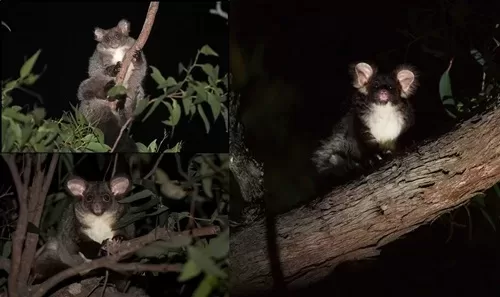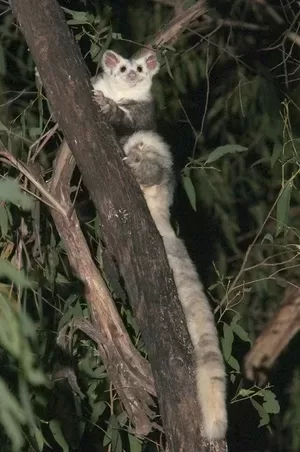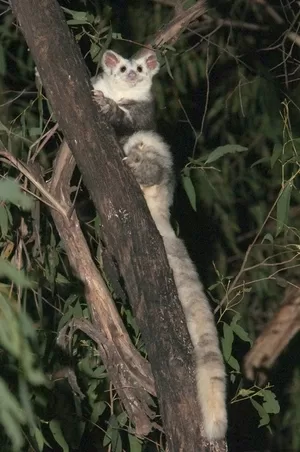Greater gliders, much larger than the more well-known sugar gliders, eat only eucalyptus leaves and live in forests along the Great Dividing Range from northern Queensland to southern Victoria. Once common, they are now listed as ‘vulnerable’, with their numbers declining fast.
The greater glider was added to Australia’s list of endangered wildlife in 2022 with their numbers declining by 80% in just 20 years. As old growth forests and tree hollows continue to be destroyed by bushfires and land-clearing, greater gliders population numbers continue to plummet.
Critical habitat for the endangered Greater Glider is being logged in Tallaganda State Forest on the South Coast of NSW by Forestry Corporation despite it being one of only two large areas of habitat to have survived the 2019/20 bushfires.
Bulga Forest near Taree is also listed for logging to commence before Christmas, despite new sightings of greater gliders by citizen scientists.
Where the Greater Glider once ruled the trees, evidence of a local extinction is unfolding in the NSW forest of Shallow Crossing, just north of Bateman’s Bay — as Australian Conservation Foundation’s Lead Environmental Investigator Annica Schoo recently discovered.
The World Wildlife Fund, Wilderness Australia, NSW Greens MP and local conservationists are all calling on Minister for the Environment, Penny Sharpe to end to logging in vulnerable habitat forests until independent surveys can establish the location of Greater Glider habitat trees.
|
See our coverage: EPA’s Stop Work Order on logging in Tallaganda State Forest
“The logging of Greater Glider Habitat in Tallaganda State Forest could be the nail in the coffin of extinction for Greater Gliders”
“Forestry Corporation have only recorded a single Greater Glider den tree in the 5,000 hectare area that they intend to log, this is completely at odds with most reports on the Greater Glider population in Tallaganda that show this population is just one of two large populations remaining in the State.”
“Here we are looking at state sanctioned extinction logging underway in habitat that is critical to the survival of the endangered Greater Glider.“
Greens MP and Spokesperson for the Environment said.


Greater Gliders, Supplied: CSIRO
What is the Greater Glider?
The greater glider (Petauroides volans) is a marsupial native to Australia. It is one of the largest gliding marsupials in the world and is known for its distinctive appearance, which includes a long, bushy tail and large, saucer-like eyes. The greater glider is primarily herbivorous and feeds on the leaves, flowers, and buds of certain tree species.
There are several reasons why it is important to save trees for the greater glider:
Habitat Loss: Greater gliders depend on old-growth forests and mature eucalyptus trees for their habitat. As these trees are cut down or degraded due to logging, urban development, or other human activities, the gliders lose their homes and food sources.
Food Source: Greater gliders have a specialized diet, primarily feeding on the leaves of specific eucalyptus species, such as the mountain ash (Eucalyptus regnans) and other mature eucalyptus trees. These trees provide the gliders with their main source of nutrition, and without them, the gliders would struggle to find adequate food.
Den Trees: Trees are not only a source of food but also serve as nesting sites for greater gliders. They often select tree hollows or cavities in older trees to build their dens and raise their young. Destruction of these trees can directly impact their breeding success.
Conservation: The greater glider is listed as a vulnerable species in several regions of Australia due to habitat loss and fragmentation. Saving their habitat is essential to the conservation of this species and preventing its decline.
To protect the greater gliders and their habitat, it is crucial to establish buffer zones around their den trees and protect the old-growth and mature eucalyptus forests they depend on. These buffer zones help minimize disturbances and provide a safe space for gliders to nest and forage.
The size of the buffer zone may vary depending on the specific location and local conservation efforts, but it is typically designed to reduce human impacts on glider habitats, such as logging or urban development, within a certain radius of the den trees.
Conservation organizations and government agencies work together to establish and enforce such protective measures to ensure the survival of this unique marsupial species.
Greater Gliders are actually three different species.
In 2020, James Cook University (JCU), The Australian National University (ANU), the University of Canberra and Australia’s national science agency, CSIRO, analysed the genetic make-up of the greater glider – and discovered they are actually three species.
Dr Kara Youngentob from ANU said the identification and classification of species are essential for effective conservation management. She said there have been alarming declines in greater glider populations in the Blue Mountains, NSW and Central Highlands, Victoria and localised extinctions in other areas.
“The division of the greater glider into multiple species reduces the previous widespread distribution of the original species, further increasing conservation concern for that animal and highlighting the lack of information about the other greater glider species.”
“The knowledge that there is now genetic support for multiple species, with distributions that are much smaller than the range of the previously recognised single species, should be a consideration in future conservation status decisions and management legislation”
Dr Youngentob said.
The research is published in Scientific Reports and can be found at: Genetic evidence supports three previously described species of greater glider, Petauroides volans, P. minor, and P. armillatus
Why is the greater glider endangered?
Without old growth forests and the hollows found in those established trees to call home, greater gliders cannot survive. Tree clearing, forest destruction, bushfires and climate change are placing greater glider populations at risk.
New research by the Australia Institute shows that a majority of voters from all major parties support bans on native forest logging in NSW.
“Native forest logging in NSW must end immediately and protection and transition arrangements put in place for the environment, communities, workers and industry”
“The majority of voters from all parties want to see the end of native forest logging in NSW, there is nothing left in the way for the State and Commonwealth Governments to end native forest logging”
said Greens MP Sue Higginson and spokesperson for the environment.
NSW is on the frontline of the extinction crisis and forest dependent threatened species like the Koala and Greater Glider cannot afford for us to keep logging our native forests.
Government not delivering
“The independent review of the Biodiversity Conservation Act headed up by Ken Henry AC explicitly stated that laws that have an objective to protect the environment must take precedence over laws that facilitate environmental harm.”
“What is happening in Tallaganda is precisely what the review says needs to change. Forestry Corporation have compiled with the letter of the Forestry Act and are now logging critical remnant habitat of an endangered species with impunity. We can’t keep destroying the habitat of species that are on the brink of extinction.”
“I’ve written to the Minister and called for her to intervene now, to keep her promise of no new extinctions in NSW, because without the Government taking action now, Greater Gliders will be reduced to just one large population area in the entire state.”
“If logging in Tallaganda continues, Greater Gliders will be pushed to extinction and this Government will be looking down the barrel of its own political failure.”
Greens MP and Spokesperson for the Environment said.


Greater Glider – Photo supplied: Steven Kuiter
“The Biodiversity Conservation Act Review was tabled in Parliament and found that the laws in NSW are failing the environment and that native forest logging is damaging forest ecosystems and the habitat of native species. Now here we are looking at state sanctioned extinction logging underway in habitat that is critical to the survival of the endangered Greater Glider.”
“The Minister must use her powers to order a halt to the logging operations in Tallaganda so that this vast discrepancy in population reporting can be resolved, Forestry Corporation have either failed to conduct adequate surveys or they are willfully misleading the Government and people of NSW.”
Greens MP and Spokesperson for the Environment said.
See our other stories on the need to rethink logging:
FORESTRY & KOALAS
Commercial Forestry of native timber forests is unviable – economically & environmentally.
Outdated threatened species surveys hasn’t stopped logging
EPA’s Stop Work Order on logging in Tallaganda State Forest
Bulga State Forest logging and protests will resume in NSW
Flawed habitat maps could derail government plans to save the Koala
The Great Koala National Park without any Koalas



